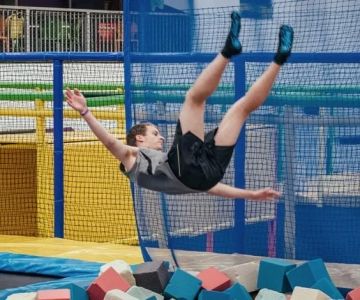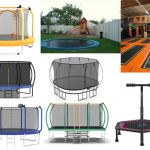- 1-Understanding-the-Causes-of-Dizziness-While-Jumping
- 2-Practical-Tips-to-Prevent-Dizziness-When-Jumping
- 3-Exercises-and-Techniques-to-Improve-Balance
- 4-Real-Life-Experience-and-Advice
- 5-Choosing-the-Right-Equipment-for-Safe-Jumping
1. Understanding the Causes of Dizziness While Jumping
Dizziness during jumping is a common concern that can arise from several factors including rapid head movements, changes in blood pressure, and inner ear balance disruptions. When you jump, your body experiences shifts in position and speed, which can confuse the vestibular system responsible for maintaining balance.
Recognizing these causes is essential to adopting effective strategies to minimize or prevent dizziness, ensuring a safer and more enjoyable jumping experience.
1.1 Vestibular System and Balance
The inner ear contains tiny structures that detect motion and help maintain equilibrium. Sudden or repeated jumps can overload this system, causing feelings of dizziness or vertigo.
1.2 Blood Flow and Oxygen Levels
Jumping rapidly may temporarily affect blood flow to the brain, especially if hydration or breathing is inadequate, leading to lightheadedness.
2. Practical Tips to Prevent Dizziness When Jumping
Several simple yet effective practices can reduce the likelihood of dizziness while jumping:
2.1 Focus Your Gaze
Fixing your eyes on a stationary point helps the brain stabilize visual input and reduces balance confusion.
2.2 Control Your Breathing
Maintain steady, deep breaths to ensure proper oxygen flow and prevent lightheadedness.
2.3 Pace Yourself
Avoid sudden, rapid jumps initially. Gradually increase intensity and duration to allow your body to adapt.
2.4 Stay Hydrated and Rested
Proper hydration and rest support overall physical function and reduce dizziness risk.
3. Exercises and Techniques to Improve Balance
Incorporating balance training exercises can enhance your body’s ability to manage movement-induced dizziness:
3.1 Balance Board and Stability Exercises
Practicing on balance boards or stability balls strengthens core muscles and improves vestibular function.
3.2 Gradual Head Movement Drills
Slowly practicing head rotations while stationary prepares the vestibular system for more dynamic activity.
3.3 Coordination Drills on a Trampoline
Using a trampoline for low-impact bouncing helps refine balance and spatial awareness under controlled conditions.
4. Real-Life Experience and Advice
Jessica, a beginner trampoline enthusiast, struggled with dizziness during early sessions. After consulting experts and following advice from Trampoline Zone, she implemented gaze-focusing and paced her jumping routine. Over weeks, her dizziness reduced significantly, allowing her to enjoy trampoline workouts safely and confidently.
Jessica’s experience highlights the importance of patience and gradual adaptation when learning how to avoid getting dizzy while jumping.
5. Choosing the Right Equipment for Safe Jumping
Quality equipment plays a critical role in reducing dizziness risks. A trampoline with proper cushioning, a stable frame, and safety nets enhances control and balance, creating a safer jumping environment.
At Trampoline Zone, you can find expert recommendations on trampolines designed to support safe jumping practices, helping both beginners and experienced users minimize dizziness and maximize enjoyment.
By understanding the causes of dizziness and applying these practical tips, you can confidently enjoy jumping activities with less discomfort. For more guidance and high-quality trampolines, Trampoline Zone is your trusted partner in safe and fun jumping experiences.







 Pump It Up Lake Forest Kids Birthday and More4.0 (280 reviews)
Pump It Up Lake Forest Kids Birthday and More4.0 (280 reviews) Urban Air Trampoline and Adventure Park4.0 (349 reviews)
Urban Air Trampoline and Adventure Park4.0 (349 reviews) Church Street Plaza4.0 (731 reviews)
Church Street Plaza4.0 (731 reviews) Fun City Adventure Park3.0 (162 reviews)
Fun City Adventure Park3.0 (162 reviews) Riki Tiki's Indoor PlayGround4.0 (35 reviews)
Riki Tiki's Indoor PlayGround4.0 (35 reviews) Urban Youth Park - South Bay4.0 (107 reviews)
Urban Youth Park - South Bay4.0 (107 reviews) Are Trampoline Parks Safe for Kids? Essential Guide for U.S. Parents
Are Trampoline Parks Safe for Kids? Essential Guide for U.S. Parents How Often Should You Replace Trampoline Springs? Tips for Proper Maintenance
How Often Should You Replace Trampoline Springs? Tips for Proper Maintenance How Much Is a Trampoline? A Detailed Guide to Trampoline Costs and Buying Tips
How Much Is a Trampoline? A Detailed Guide to Trampoline Costs and Buying Tips Bounce Techniques for Stronger Legs: Effective Exercises and Tips
Bounce Techniques for Stronger Legs: Effective Exercises and Tips Essential Music Gear for Trampoline Dance: Complete Guide
Essential Music Gear for Trampoline Dance: Complete Guide Fun STEM Experiments Using Trampolines to Spark Curiosity and Learning
Fun STEM Experiments Using Trampolines to Spark Curiosity and Learning